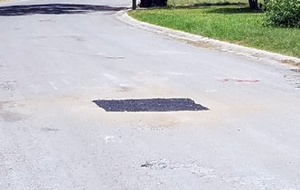A Devine PD officer observed a sink hole in the 200th block of Harralton Circle this past Thursday, August 1 around 9:30 am.
“The sink hole is in the westbound lane of Harralton Circle (as you are exiting the neighborhood), and is about 2 feet across and 4-5 feet deep,” said Devine PD Lieutenant Chris Andrews. “Thankfully it was discovered before anyone drove over that area.”

Crews were digging and patching it this Monday.
The last sinkhole we can recall reporting on in this area was in Lytle, almost one year ago. It was in September of 2018 that a resident discovered a large gaping sink hole in Lytle at the intersection of San Jose and Hildago Street. That sink hole was about 10-12 feet wide.
According to the U.S. Geological Survey, Sinkholes can vary from a few feet to hundreds of acres and from less than 1 to more than 100 feet deep. Some are shaped like shallow bowls or saucers whereas others have vertical walls; some hold water and form natural ponds. The following is additional information regarding sink holes from USGS.gov:
A sinkhole is an area of ground that has no natural external surface drainage–when it rains, all of the water stays inside the sinkhole and typically drains into the subsurface.
Typically, sinkholes form so slowly that little change is noticeable, but they can form suddenly when a collapse occurs. Such a collapse can have a dramatic effect if it occurs in an urban setting.
The most damage from sinkholes tends to occur in Florida, Texas, Alabama, Missouri, Kentucky, Tennessee, and Pennsylvania–some in Florida are so large they look as if they are eating a swimming pool, roadway, and buildings.

